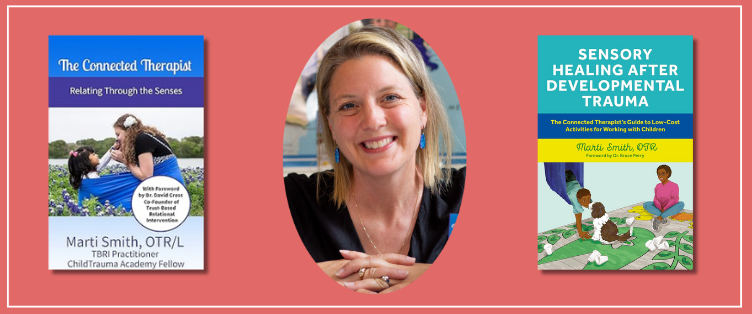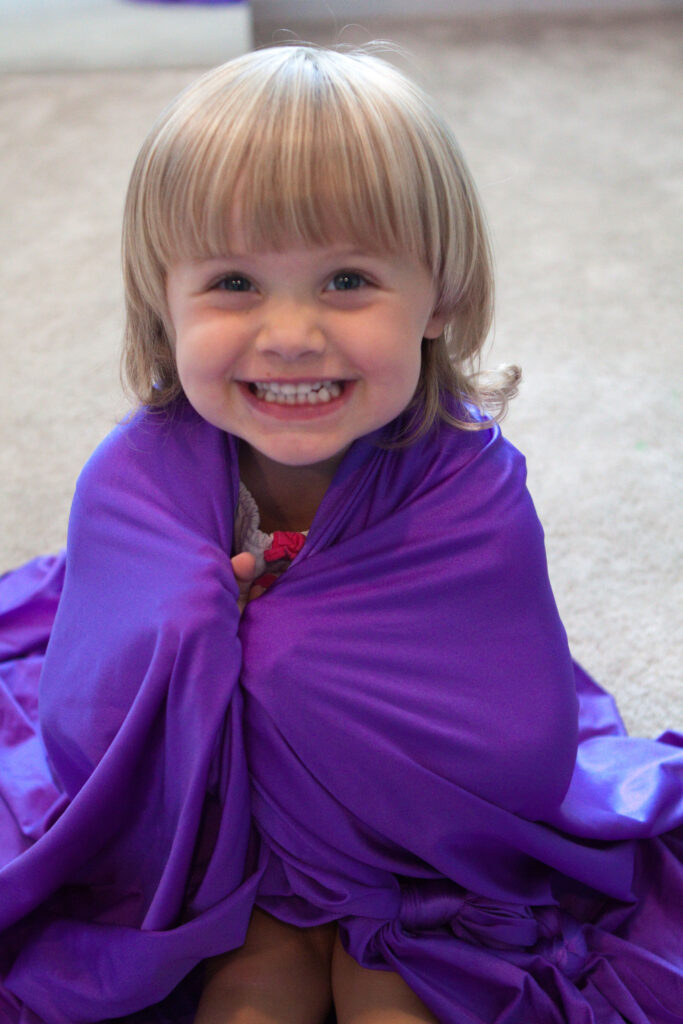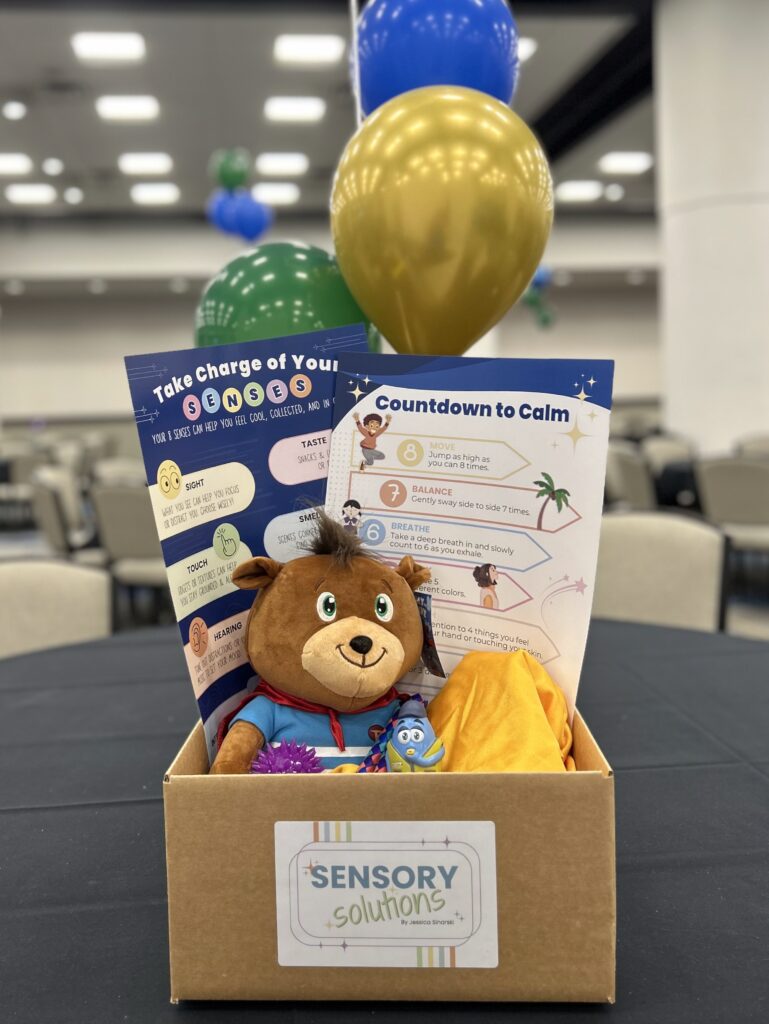Tips for Therapy, Home, and School
I came across the work of Marti Smith, OTR when I was still in the therapy office. We developed a friendship across the miles as I was working on Riley the Brave’s Sensational Senses. And when her new book Sensory Healing after Developmental Trauma came out, I scooped it right up!

One of the things I love about Marti is her ability to provide concrete tools for complex challenges. And one of her favorite tools is Lycra! So, I recently reached out to her with this question:
What can teachers, parents, and therapists do with one yard of lycra?
Lycra is an incredible resource for supporting sensory integration, motor development, and emotional regulation. Whether used at home, in therapy, or in the classroom, its stretchiness provides calming proprioceptive input that helps individuals find the steadiness they need through movement and deep pressure.
You can find four-way stretch Lycra (also called Spandex or stretch fabric) at places like SpandexByYard or Stretch House. Choose a color and texture that fits your setting: sometimes calming, sometimes energizing!
Marti has scores of ways to use this powerful tool, but before diving into specifics, it’s essential to remember that Lycra is most therapeutic when the individual has complete control over the stretch, timing, and duration of the activity.
Lycra should never be used as a form of restraint, punishment, or consequence.
Five Classroom-Friendly Ideas
For educators looking to integrate sensory regulation tools into their classroom routine, Lycra offers versatile options that are both practical and easy to manage:
- Proprioceptive Seating Aid Offer to wrap Lycra tightly around a child’s thighs while they are seated and tuck it underneath to provide firm proprioceptive input. This is especially helpful during group work or circle time to help students stay focused and calm.
- Visual Boundaries for Circle Time Lycra can be spread on the floor to create clear, soft boundaries for where students should sit during circle time. This non-verbal cue supports children’s spatial awareness without distracting them from the group activity.
- Sensory Lap Blanket Encourage students to stretch Lycra across their lap during seated activities, tucking it securely under their thighs. This provides proprioceptive input that can help with focus and self-regulation during quiet work time.
- Classroom Sensory Wall Create a safe sensory “wall” by securing Lycra in a doorframe or between two stationary points in the classroom. This allows children to get their Tiger or Porcupine energy out as they crash, push, or lean against it for calming proprioceptive feedback during sensory breaks.
- Turtle Moment Tool Create a snuggly space to work through Turtle moments by tying Lycra to a table and allowing it to hang down. This provides a calming retreat where they can relax, regroup, and re-energize their Upstairs Brain.

At Home or in Therapy
Here are 9 fun and effective ways to use one yard of Lycra for sensory support at home or in therapeutic settings:
- Lycra Cape or Hoodie Stretch Spread the Lycra flat on the floor, sit on one edge to hold it steady, and grab the opposite side behind your body. Pull it forward and around you like a cape or hoodie. This provides excellent proprioceptive input to the shoulders and head, helping individuals feel grounded and focused.
- Floor Stretching with Resistance With two people holding down the Lycra corners, someone can slip between the Lycra and the floor. The person can commando crawl underneath or push up against the resistance, strengthening muscles and providing deep pressure input for calming.
- Stretchy Door Resistance Create a horizontal band of Lycra by securing the knots in a doorframe. The individual can slip between the door and the Lycra, feeling playful resistance. Parents can safely push or touch through the Lycra for an interactive sensory game, guessing body parts or creating imaginary creatures.
- Roll-Up Burrito Lay the Lycra flat on the floor, have the child lay along one edge, and roll themselves up like a burrito. This provides full-body pressure, helping them feel secure, calm, and regulated.
- Stretchy Wrap Simply wrapping Lycra snugly around the torso can offer deep, calming pressure. This is great for moments of sensory overload or when in need of a focus boost.
- Turtle Table Hideaway Tie the corners of the Lycra to a table, creating a hanging space underneath. This provides a cozy sensory haven where children can snuggle in for a sensory break or to relax.
- Walking on Air Two adults can hold the Lycra’s corners to create a suspended sheet. The child can walk across it, experiencing the stretchy resistance that helps them improve balance and motor planning. Adults can also bounce the child gently, simulating a no-gravity experience or a walk through clouds.
- Lycra Hammock or U-Shape Play Knot the four corners of the Lycra and secure two knots in a doorframe. The result is a flexible U-shape that can become a hammock, moonwalk, or stormy seas adventure! It’s great for stimulating balance and body awareness through rocking, bouncing, or gentle swinging. This video demonstration offers a closer look at how to use Lycra for sensory play like this.
- Tiger Wall Crash Hold the Lycra taut between two adults, creating a safe “wall” for the child to crash into. The soft resistance provides proprioceptive feedback while keeping the activity safe and fun. Roaring is optional 😉
Lycra is a powerful, versatile tool for sensory regulation.
With the opportunity for movement and deep pressure, it can increase relaxation, focus, and even a sense of safety. For more ideas and professional guidance on the therapeutic use of Lycra, be sure to check out Marti Smith’s book Sensory Healing after Developmental Trauma or visit her website: www.CreativeTherapies.com.
Simple, effective sensory tools like Lycra can make a world of difference for kids learning to regulate big feelings. The Mindful Kids Sensory Pack is filled with easy-to-use resources to help children find their calm and focus—no complicated setups required. It’s perfect for home, office, or classroom!
Ready to bring some Sensory Solutions to your entire school or organization?
Go to www.JessicaSinarski.com/EDU to learn more.
